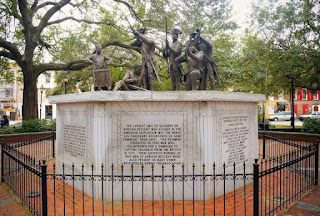In his essay "Standing Tall: Three statues, three lessons" Randell Jones writes about another type of heroic statue; one that commemorates the human spirit, and the things that constitute a life well-lived. The writing honors two individuals (an enslaved Black man named "York", Dr. Simon Green Atkins, a Black intellectual) and a regiment of Black African men born in bondage in Hayti, and conscripted as mercenaries/military recruits to fight in America's Revolutionary War.
"Philosophers offer that a sense of a life well-lived comes from having something to love, something to do and something to hope for. Those elements are represented in the stories of three notable people, each represented by a statue, all in the South."
—Randell Jones
The philosopher who posited that a life well-lived is one with love, hope, and opportunity is Aristotle. In his Nicomachean Ethics, Aristotle discusses the concept of eudaimonia, which is often translated as “happiness” or “flourishing.” According to Aristotle, eudaimonia is the ultimate goal of human life and is achieved through living virtuously. He believed that a life well-lived is one in which individuals cultivate virtues such as love, hope, and opportunity, leading to a state of flourishing and fulfillment.
ASIDE: To his credit, on his deathbed, Aristotle confessed to his student that he had plagiarized some of his works from ancient Egyptian sources. This confession shed light on the irony of this essay, which attributes to "philosophers" , a sentiment which was likely passed on by Black Africans of Ancient Egypt, but adopted as Greek philosophy without attribution. In other words, the Greeks plagiarize liberally from Ancient Egyptians. Cultural appropriation is not exactly "the intellectual exchange between the two civilizations" that is represented by mainstream intelligentsia.
The essay is fine, until the extremely bigoted over simplification of the Haitian Revolution (1791–1804):
Randell's slapdash portrayal is the typical intellectual dishonesty we have come to expect from White historians (even in the effort to credit lost or little known Black historical figures!). To summarize the French military and it's Spanish, Polish and other European mercenary's defeat simply as: "Having lost 37,000 soldiers to yellow fever in Saint-Domingue [Hayti] and needing money for his war with Great Britain, in 1803, he offered to sell France’s Louisiana territory to the fledgling United States" is disrespectful, to say the least.
The Haitian Revolution was won for the freedom of enslaved people through the long-term planning[5], strategies and skill of its great soldiers/fighters (Makandal, Boukman, Toussaint, Dessalines, "Capois-La-Mort", Henri Christophe, Rigeau, Petion, Boyer... ) and brave women (Dahomey warriors, Victoria "Tante Toya" Montou), Cecile Fatima, Marie-Jeanne Lamartiniére, Suzanne Béliar, Marie Sainte Dédée Bazile, Catherine Flon...). It is an unconscionable injustice and beyond the pale (pun intended) to suggest otherwise.
[5](Cecile Fatima traveled to Plantations recruiting for the rebellion for two years before the 1791 Bwa Kayimen ceremony that launched the Haitian Revolution)
In this historical letter between Toussaint L'Ouverture and Jean-Jacques Dessalines; Toussaint directs the strategical way to defeat the French army, and this is precisely how they were dispatched. The great François "Capois-La-Mort" Capois courage at the Battle of Vertières being a brilliant example of the bravery and courage of the Armée Indigène (Indigenous Army).
It is a deeply concerning matter to just lightly skip over the part where Blacks fought thirteen (13) years of battles and skirmishes, and suffered more casualties than the United States in WWI[1].
The obvious needs saying here; these casualties are estimates, and the Haitian casualties are most assuredly downplayed.
The Haitian Revolution casualties and losses:
Haitians: 350,000+ dead
France: 75,000+ dead
British: 45,000+ dead
Spain: [100,000+] /"heavy losses"[2]
[1] During World War I, the U.S. suffered a total of 116,516 military casualties.
[2] The exact number of deaths from Spain during the Haitian Revolution is not definitively documented. However, it is estimated that thousands of Spanish soldiers and civilians lost their lives during the conflict.
Speaking of "heavy losses"...
Randell Jones: "10% of the island’s 550,000 population were the white elites and the mixed-race merchants and tradesmen. Ninety percent of the population were enslaved people brutally forced to work to maximize their productivity before they died of yellow fever in a year or two and were easily replaced in a steady African slave trade."
At 90%, the total number of enslaved on Ayiti were 495,000. Over 350,000 died for freedom, that's a genocide of over 60% of the enslaved Black people.
General Jean-Jacques Dessalines of the self-titled Armée Indigène ("Indigenous Army") declared:
"Yes, we have rendered to these true cannibals war for war, crime for crime, outrage for outrage; yes, I have saved my country; I have avenged America." He named the new Black Republic "Hayti" after the indigenous name given by the Taino, including the Higüey, Mariéns, Caracole (Black Moors[4]), Xaragua, Maguá, and Maguána.
[4] Spain was one of the major powers involved in enslaving African people, the vast majority of enslaved Africans were sent to Spanish colonies in the Americas. Some enslaved Africans were Moorish. No good deed (civilization, liberal arts schools, cities and street planning, WINE...) goes unpunished.
Henri Christophe unfortunately plotted with the mixed race sons of France the assassination of Dessalines (he was sort of a despot), and deeply regretted this; so depression (and his rebellious subjects, joined in rebellion by members of his army) may have lead to his suicide.
Also, why shouldn't a King of Hayti live a comfortable life (especially a triumphant battle worn general and hero)? Why are you counting his money; to distract from his accomplishments? In his time, Henri Christophe built the The Palace of Sans-Souci and Fort Citadelle Laferiere[3], structures which still stand today as monuments to honor his triumphant achievements and Hayti's halcyon days of glory.
[3] (a mountaintop fortress, located on the northern coast of Haiti - considered one of the eight wonders of the world and designated by the UNESCO as a World Heritage Site in 1982)
Haiti declared its independence on January 1, 1804, becoming the first nation to permanently abolish slavery, 30 years before Great Britain, over 40 years before France, and more than 60 years before the US.
Liberté ou Mort
Armée Indigène
In the essay, we learn about the virtues of the enslaved "York", and by contrast, the petty jealousies of his enslaver William Clark: " upon the expedition’s return, Clark continued to enslave him as property. Through all the adventures and encounters with new people, York had changed immensely, but Clark not at all."
STATUES
______________
Something to love: Freedom
The Haitian Monument commemorates the contributions of the Chasseurs-Volontaires de Saint-Domingue, a French regiment of free men of African descent, during the American Revolution.
The young drummer boy, who stands just to the left of the armed group, is Henri Christophe, an important leader in the Haitian Revolution and the only monarch of the Kingdom of Haiti.
Something to hope for: A better self
York, York's statue is at Lewis & Clark College in Louisville, KY overlooking the Ohio River. The statue honors York, the enslaved Black man who accompanied the Lewis & Clark expedition.
Something to do: Opportunity
Simon Green Atkins Statue, Simon Green Atkins: a statue of Dr. Atkins
#SavannahGeorgia
#LouisvilleKentucky
#NorthCarolina












No comments:
Post a Comment